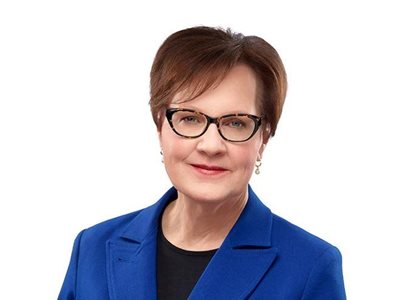Ahead of our sold-out Transportation Symposium: Are We There Yet?, we are speaking with some of the industry experts who will be leading conversations throughout the day. The symposium will convene industry leaders, visionaries, and experts to dissect the long-term trends impacting transportation, transit, and urban mobility across the Toronto Region,
Our region is on the cusp of a transportation revolution, with more than $80-billion in transit capital projects underway. To stay ahead of the curve, our infrastructure plans must keep pace with the region’s growth to effectively support its evolving needs and demands. Historically, our region has struggled to deliver massive infrastructure on time and on budget.

We spoke with Godyne Sibay, Senior Strategic Advisor & Counsel at McCarthy Tétrault, to explore the multifaceted challenges and opportunities that define our path forward in infrastructure development.
As we navigate through this historic period of infrastructure development in our region, could you share your insights on the significance of collaboration for ensuring these projects not only meet their deadlines but also remain within budget?
Godyne Sibay: Collaboration is critical. My journey through various projects has cemented my belief in the invaluable role of bringing together diverse perspectives, expertise, and resources. As a senior infrastructure, projects and real estate lawyer, it’s clear that partnership between the public and private sectors is not just beneficial but imperative to the delivery of public infrastructure.
Nowhere is the value of collaboration more evident in facilitating on-time and on-budget delivery than the models used by Infrastructure Ontario and Metrolinx. Rather than treat the private sector as simply a contractor, these delivery models help allocate the risks of project delivery between the public and private sector in a manner that motivates both parties to see the project completed successfully. An example is the Public Private Partnership (P3) model that has been successfully used to deliver dozens of major public infrastructure projects in the past 20 years.
While not strictly a public infrastructure project, another example of a project that exemplifies the value of public and private multi-stakeholder collaboration was the revitalization of Massey Hall. That project not only preserved a historic landmark but also enhanced the capacity of Massey Hall to serve future generations.
Collaboration, or the lack thereof, is where projects succeed or fail. It’s through collaboration that we’re able to navigate unforeseen challenges and adapt to changing circumstances.
Since you mentioned public-private partnerships (P3s), let’s spend a bit more time on this. P3s have been instrumental in advancing major infrastructure projects. How do you see the role of P3s evolving in the Toronto Region's infrastructure landscape?
GS: Public-private partnerships have not only been instrumental to Toronto’s infrastructure landscape but have also positioned Ontario as a leader in the P3 market. Among other benefits, P3s show how infrastructure challenges can be addressed through innovative financing and collaborative project delivery. They’ve also brought the value of private sector innovation to public projects and provided significant and sustained improvements to the Ontario government’s ability to have projects delivered on-time and on-budget.
In recent years, the P3 model has faced some challenges with supply chains, availability of skilled labour and some P3 players leaving the market. But the model was designed to be resilient and adaptive, and public infrastructure projects continue to benefit from delivery based on the P3 model. Moreover, we’re seeing delivery agencies in Ontario taking steps to address these challenges by introducing new models, such as progressive P3s, which introduce additional design collaboration with the private sector earlier in the procurement process and foster a shared problem-solving mindset.
I expect that the P3 model will continue to adapt to market conditions, and play an important role in the delivery of new hospitals, transit projects and other major public infrastructure projects.
There’s no denying many of our region’s large infrastructure projects have run into speedbumps. Given the complexity of these projects, how can we better manage risks to avoid common pitfalls?
GS: Managing risks in infrastructure projects requires a proactive and strategic approach. It starts with recognizing that risks are multifaceted and can arise from various sources – be it financial, technical, or environmental. Effective risk management is about anticipating these challenges before they manifest. This means conducting thorough risk assessments, engaging with stakeholders early and often, and being nimble enough to adjust our strategies in response to new information or changing circumstances. It also involves learning from past projects, both our own and those of others, to avoid repeating the same mistakes.
I give credit to the Province’s two major infrastructure delivery agencies – Infrastructure Ontario and Metrolinx – for embracing this strategic approach and adopting lessons-learned from past projects in the portfolio of new projects we’ve seen rolled out in recent years.
With the importance of maintaining public trust, what strategies can be employed to enhance community engagement and support for large projects?
GS: Building and maintaining public trust requires a commitment to transparency, accountability, and ongoing dialogue with the community. It starts with effective communications to demonstrate the value and impact of a proposed project on people’s lives. It then leads to engaging with residents and stakeholders to provide the community with a forum to communicate their questions and concerns. By fostering a sense of ownership and partnership with the community, we can enhance support for large projects and ensure they truly serve the public interest.
Amongst other initiatives, you are a founding member of the Toronto chapter of Women in Infrastructure (WIN), an organization that facilitates connections and networking, idea exchange, and helps to shape the infrastructure agenda. In your career, how has the conversation around the business case for diversity and inclusion in the industry shifted?
GS: Since the founding of WIN, the conversation around diversity and inclusion in the infrastructure sector has shifted dramatically. There's a growing recognition of the value that diverse perspectives bring to our work, not just in terms of fairness and equity but also in enhancing project outcomes and innovation. This shift has been driven by a combination of advocacy, changing societal norms, and the demonstrated success of diverse teams.
To maintain this momentum, we’ll need to continue to focus on intentional actions and systemic changes. This includes addressing barriers to entry and advancement for underrepresented groups, implementing policies and practices that promote diversity and inclusion, and fostering a culture that values and respects diversity but also, even more importantly, integrated into decision-making and direction. Mentorship programs, professional development opportunities, and targeted recruitment efforts can also play a significant role. I'm encouraged by the progress we've made and the increasing willingness of industry leaders to embrace diversity as a strategic advantage.
The interest in our upcoming symposium has been overwhelming, so the topics we're set to explore are clearly resonating across the industry. Given the diversity of professionals and experts from numerous sectors in attendance, what key insights do you envision participants take away from this event?
GS: I’m very excited about our upcoming discussion because I think it’s a great opportunity to celebrate the great successes we’ve had in the transportation infrastructure space, and also to talk about opportunities to consider doing some things differently. These panelists have deep experience at delivering projects and will, without a doubt, be able to bring a lot of knowledge and insight to that conversation.
In preparing our city and region for the future, the stakes are high. We know that we face challenges when it comes to providing adequate housing and transportation for a growing population, while simultaneously tackling our climate goals. Big and audacious projects will be an important part of the plan and we need to be ready to embrace them. But we are prepared - we do have many advantages as noted above. So I am really looking forward to the conversation as a step towards ensuring that we continue to be at the forefront of the delivery of critical and world class projects.
Thank you to our Transportation Symposium partners.





